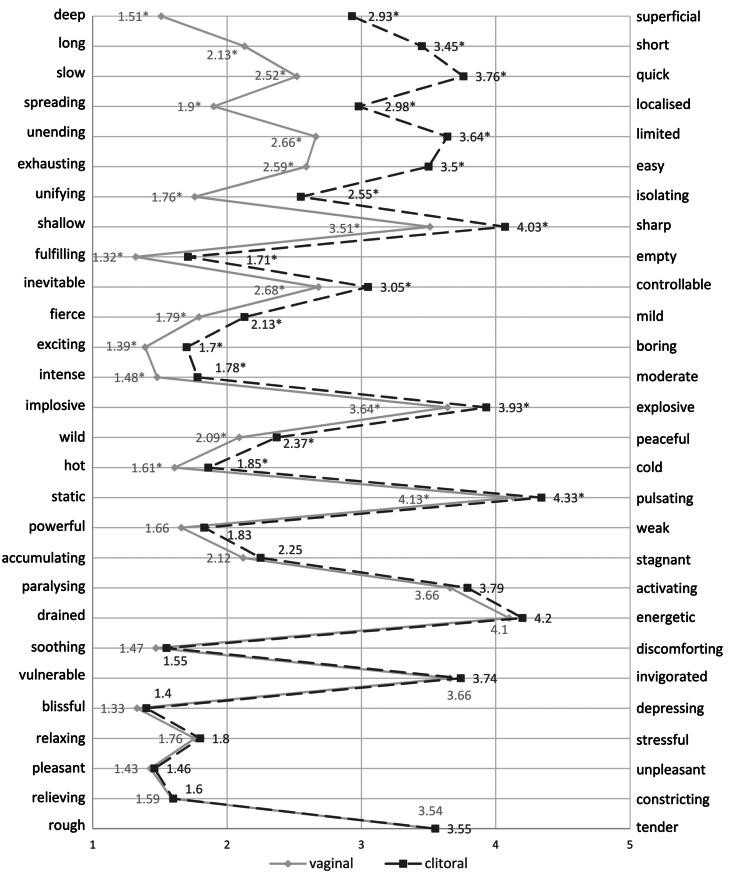For many, the topic of female orgasm remains shrouded in mystery and sometimes, controversy. While scientific discussions often delve into the anatomy and physiology of sexual response, the subjective experiences of women themselves are frequently overlooked. This article aims to explore what an orgasm actually feels like for women, drawing from a detailed study that captured the diverse ways women describe their most intimate experiences of pleasure. By understanding these varied descriptions, we can move beyond simplified notions of female orgasm and embrace the complexity and richness of women’s sexual experiences.
Understanding the Nuances of Orgasm: Beyond “Clitoral vs. Vaginal”
The debate about female orgasm has historically been dominated by the question of whether there are different types of orgasms, particularly the distinction between “clitoral” and “vaginal” orgasms. Some theories propose that all orgasms are fundamentally clitoral, given the clitoris’s central role in female sexual pleasure. This perspective often emphasizes that vaginal stimulation also indirectly stimulates the internal structures of the clitoris.
However, neuroimaging studies reveal that stimulating different areas like the clitoris, vagina, and cervix activates distinct regions of the brain, suggesting the potential for different kinds of orgasmic experiences. Adding to this complexity, women’s own descriptions often differentiate between orgasms felt from different types of stimulation. Clitoral orgasms are often described as localized, sharp, and quick, while those associated with vaginal stimulation are frequently characterized as deeper, longer-lasting, and more diffused.
It’s crucial to acknowledge that reducing the experience of orgasm to a simple “clitoral versus vaginal” dichotomy may oversimplify the reality of women’s sexual experiences. The focus should shift towards understanding the full spectrum of sensations and subjective feelings that women report.
What Women Say: Diverse Orgasmic Experiences
A recent study delved into the subjective experiences of over 500 women, asking them to describe what different types of orgasms felt like. Their responses paint a vivid picture of the diverse landscape of female pleasure.
Clitoral Orgasms: The Most Common Experience
Clitoral orgasms were the most frequently reported type. While universally described as pleasurable, women’s accounts sometimes hinted at a sense of these orgasms being less significant or lacking compared to other types. Some expressed it as “only knowing the clitoral orgasm,” as if it were a default rather than a pinnacle of pleasure.
However, many women also described clitoral orgasms positively, highlighting their reliability and controllability. One woman described the sensation as “tingly, like before a sneeze, just pleasant, like being pushed over a cliff and not being able to do anything about it. Very relaxing afterward and yet spreading out in waves.”
The intensity of clitoral orgasms varied greatly. Some women experienced them as overwhelming and intense, while others found them to be shallower or shorter, especially when compared to vaginal orgasms. One woman described the sensation as “heat… At first only in the intimate area and then in the whole body. The feeling is very short and is not always there.”
Despite the variations, it’s clear that clitoral orgasms are a significant source of pleasure for women, and the experience itself is far from monolithic. The study highlighted that even within clitoral orgasms, there’s a wide range of sensations – from “short and almost disappointing to long and all-consuming.”
Mixed Clitoral and Vaginal Orgasms: Enhanced Intensity
Many women reported that simultaneous stimulation of both the clitoris and vagina resulted in a more intense orgasmic experience than clitoral stimulation alone. It wasn’t necessarily a different kind of orgasm, but rather a heightened degree of intensity. One woman described, “Clitoral and vaginal combined orgasms feel much more intense, longer and ‘fuller’ for me. More fulfilling somehow.”
These “mixed” orgasms were sometimes described as “whole-body orgasms,” indicating a sensation that extends beyond the genitals. One participant shared, “But the best is the combination of both. It’s a huge explosion and lasts the longest. My whole body orgasms. Hard to describe.” Some women even reported experiencing squirting alongside these mixed orgasms, adding another layer of intensity to the experience.
Vaginal Orgasms: Deeper and More Elusive
Vaginal orgasms were often contrasted with clitoral orgasms, described as longer-lasting, deeper, and less localized. Women often emphasized that these orgasms were more challenging to achieve, requiring specific conditions like the right position, manual stimulation, and a relaxed mental state. Emotional connection with a partner and extended foreplay were also frequently mentioned as factors contributing to vaginal orgasms.
One woman described a vaginal orgasm as “A tornado, completely detached and total tension, ending in pleasant emptiness and vulnerability.” This highlights the intensity and sometimes overwhelming nature of this type of orgasm, followed by a sense of release and openness.
While often considered more “valuable” due to their perceived difficulty to achieve, vaginal orgasms were not universally praised. Some women found them to be “fireworks,” while others described them as “not that spectacular” or even “like you have to pee,” indicating a wide spectrum of subjective experiences even within this category. Similar to clitoral orgasms, vaginal orgasms also exhibited intraindividual variance, with one woman describing different “heights of flying” within her vaginal orgasmic experiences, ranging from “short and flat” to “extended medium-high or really great, distinct long high flights.”
G-Spot Orgasms: A Specific Point of Pleasure
A small number of women specifically mentioned orgasms originating from the “G-spot.” These were described as being triggered by penetration, particularly when combined with vibration. One woman described it as a “warm rising sensation from the lower abdomen, rising tension from the pelvis, possibly combined with squirting.” The inclusion of squirting in some descriptions of G-spot orgasms suggests a potentially distinct physiological component for some women.
Cervical Orgasms: Deep and Calm
Cervical orgasms were the least described, but those who mentioned them characterized them as “much deeper inside, almost in the uterus.” One woman elaborated, describing a calmer, more controlled sensation: “Orgasm was never too strong, not too intense, quite calm. Found it pleasurable, relaxing… I felt it as if my body sensation went up a hill, and then very quietly crossing it and bringing me back to bed. Slope was somehow controlled.” This description contrasts sharply with the explosive nature often associated with clitoral or mixed orgasms, suggesting a different quality of pleasure.
Anal Orgasms: Intense and Surrendering
Anal orgasms, though not frequently mentioned, were described as intense and long-lasting. Women emphasized a feeling of surrender and letting go. One participant described them as “the strongest and lasting the longest… The high flying/floating feeling is not there, but a deep and very intimate feeling of letting go/relaxation is.” The focus on “letting go” suggests a psychological component where vulnerability and surrender enhance the physical sensations.
Whole-Body Orgasms: Ecstasy and Transcendence
Whole-body orgasms were often described with superlatives, as “the most fulfilling, in total relaxation and surrender.” These experiences were sometimes linked to out-of-body sensations, with one woman recounting, “I saw stars, my whole body went completely numb, my brain completely relaxed, and I no longer knew where I was, who I was, or why.” These orgasms were also described as energizing and deeply connected to emotional intimacy with a partner, often requiring time, intense foreplay, and a strong emotional bond.
Non-Genital Orgasms: Pleasure Beyond the Usual Zones
Intriguingly, some women reported experiencing orgasms through stimulation of non-genital areas, like the neck, earlobe, or breasts. One woman described these experiences as “incredible.” There were also accounts of orgasms triggered by dreams during sleep, without any physical stimulation, and even orgasms induced by psychoactive substances, demonstrating the diverse pathways to orgasmic experience. One woman who had “sleep orgasms” described them as “by far the strongest of all,” highlighting the unexpected intensity of these less conventional orgasmic pathways.
Semantic Differences: Clitoral vs. Vaginal Orgasms
To further quantify the differences between clitoral and vaginal orgasms, the study used a semantic differential, asking women to rate these experiences using pairs of opposing adjectives. The results revealed significant differences in how women perceived these two types of orgasms.
Clitoral orgasms were consistently rated as:
- Sharper
- Easier
- More controllable
- Superficial
Vaginal orgasms, on the other hand, were described as:
- Wilder
- Deeper
- More pulsating
- Extending
- Unifying
- Exhausting
Figure 1: Semantic differential ratings comparing experiences of clitoral and vaginal orgasms, highlighting significant differences in descriptive adjectives.
Interestingly, there were no significant differences in ratings for adjectives like “pleasant,” “powerful,” “blissful,” “soothing,” or “energetic” between clitoral and vaginal orgasms. This suggests that while the qualities of sensation differ, both types are equally capable of producing intense pleasure and positive emotional states.
The Subjectivity and Learning of Orgasm
The study underscores the profound subjectivity of orgasmic experiences. What one woman describes as “fireworks,” another might find “not that spectacular.” This variability highlights the importance of individual anatomy, personal history, and learned experiences in shaping sexual pleasure.
The concept of “pleasure literacy” becomes crucial here. Just as we learn to read and write, women can learn to understand and enhance their capacity for sexual pleasure. This involves exploring one’s own body, becoming attuned to different sensations, and developing a vocabulary to describe and communicate these experiences. Playful self-exploration, both alone and with trusted partners, can be vital in establishing neurological pathways for pleasure and expanding one’s erotic body map.
Figure 2: Frequency of different orgasmic experiences reported by women, illustrating the prevalence of clitoral, vaginal, and mixed orgasms, as well as less common types like whole-body and anal orgasms.
This learning process is not always straightforward for women. Historically, and even today, female genitalia and pleasure are often less openly discussed and explored compared to male sexuality. This can lead to a lack of awareness and understanding of one’s own potential for pleasure. Encouraging open conversations about female sexuality and promoting pleasure-positive sex education are vital steps towards increasing pleasure literacy.
Conclusion
The experiences shared by these women clearly demonstrate that the reality of female orgasm is far more nuanced and diverse than simplified models suggest. While the debate about “all clitoral” versus “clitoral and vaginal” orgasms continues, it’s essential to recognize that these categories alone fail to capture the full spectrum of women’s subjective experiences.
“What Does An Orgasm Feel Like?” The answer, it turns out, is richly varied and deeply personal. It can be sharp and explosive, deep and expansive, calm and uterine, or even transcend the physical body entirely. Understanding and valuing this diversity is crucial, not only for research and sex education but also for empowering women to explore, understand, and celebrate their own unique experiences of pleasure. Moving forward, it’s time to integrate anatomical, physiological, and, most importantly, experiential data to create a more comprehensive and pleasure-positive understanding of female orgasm.

